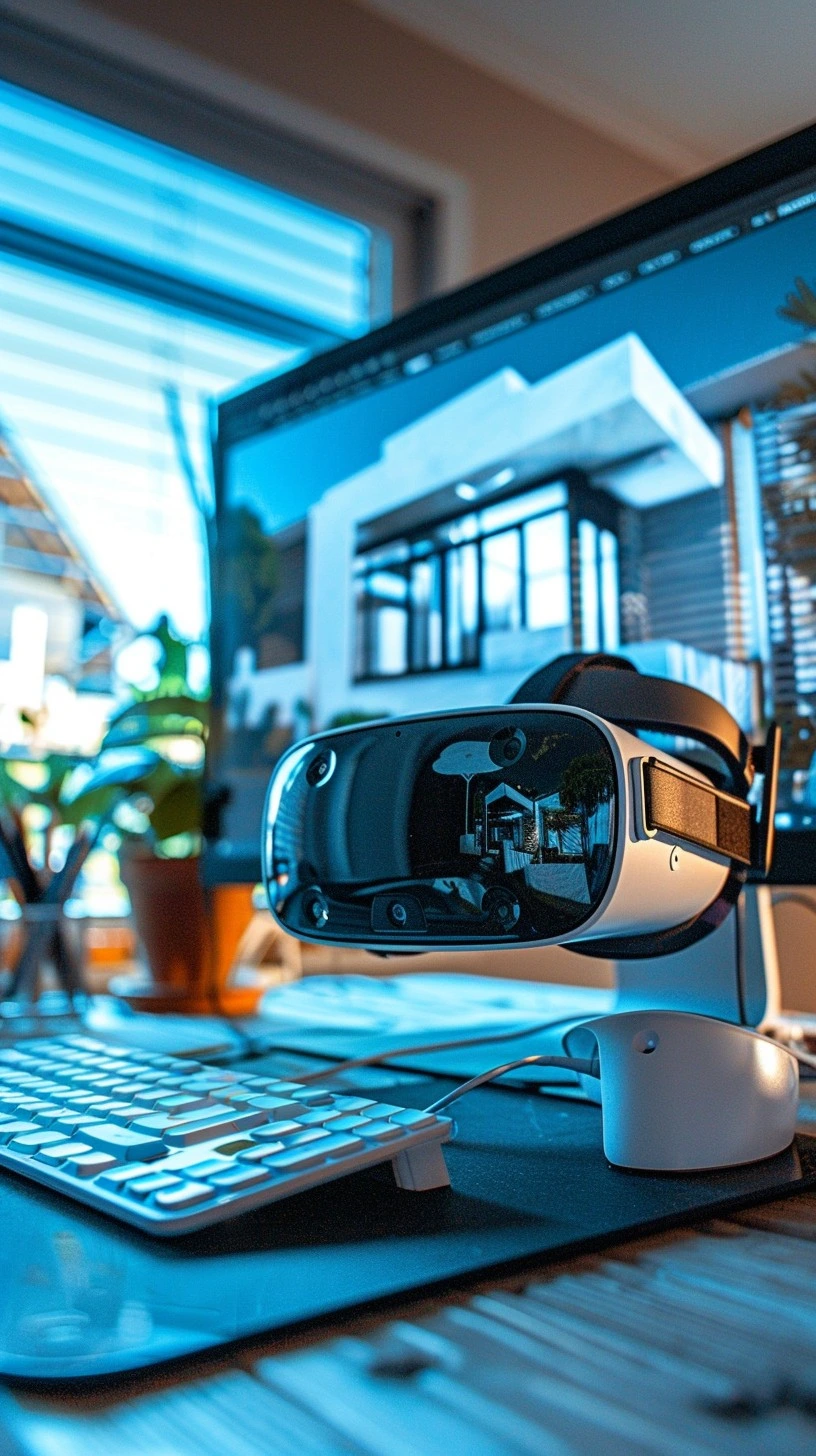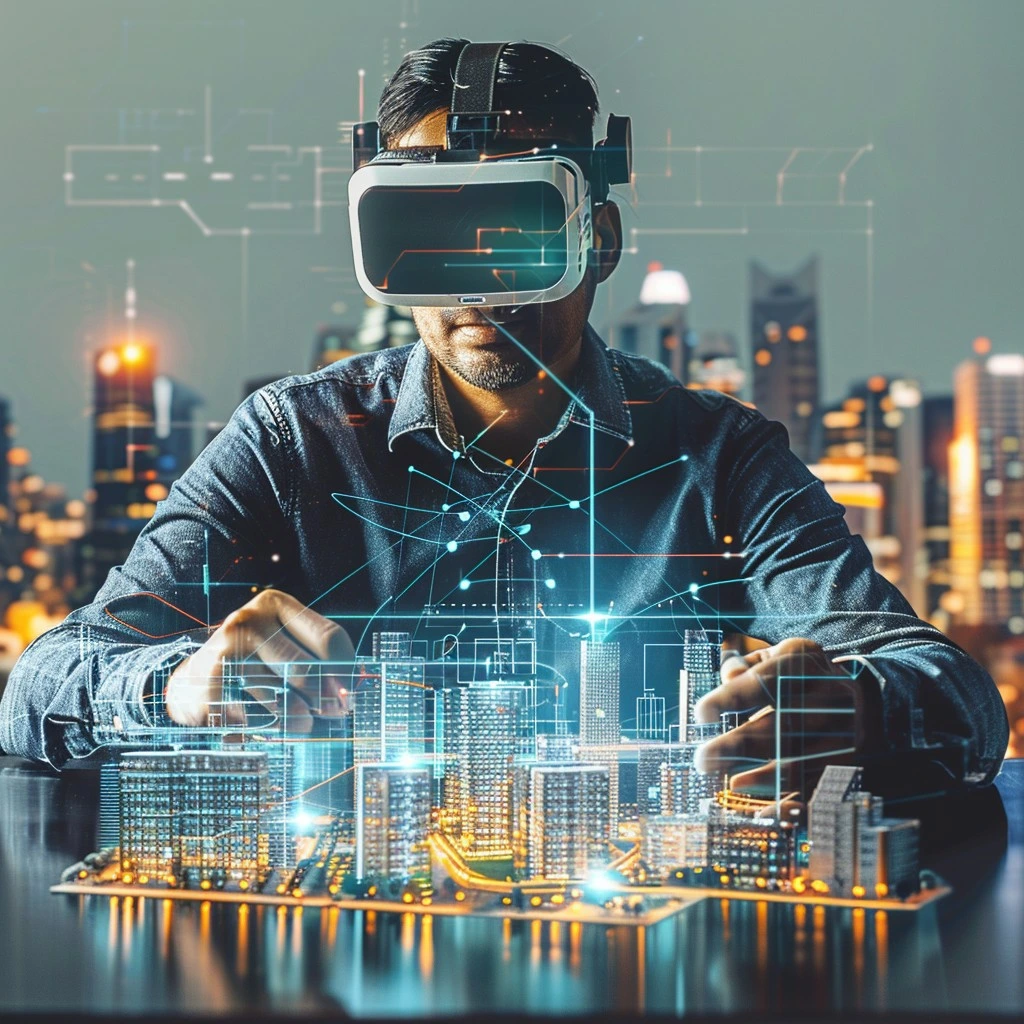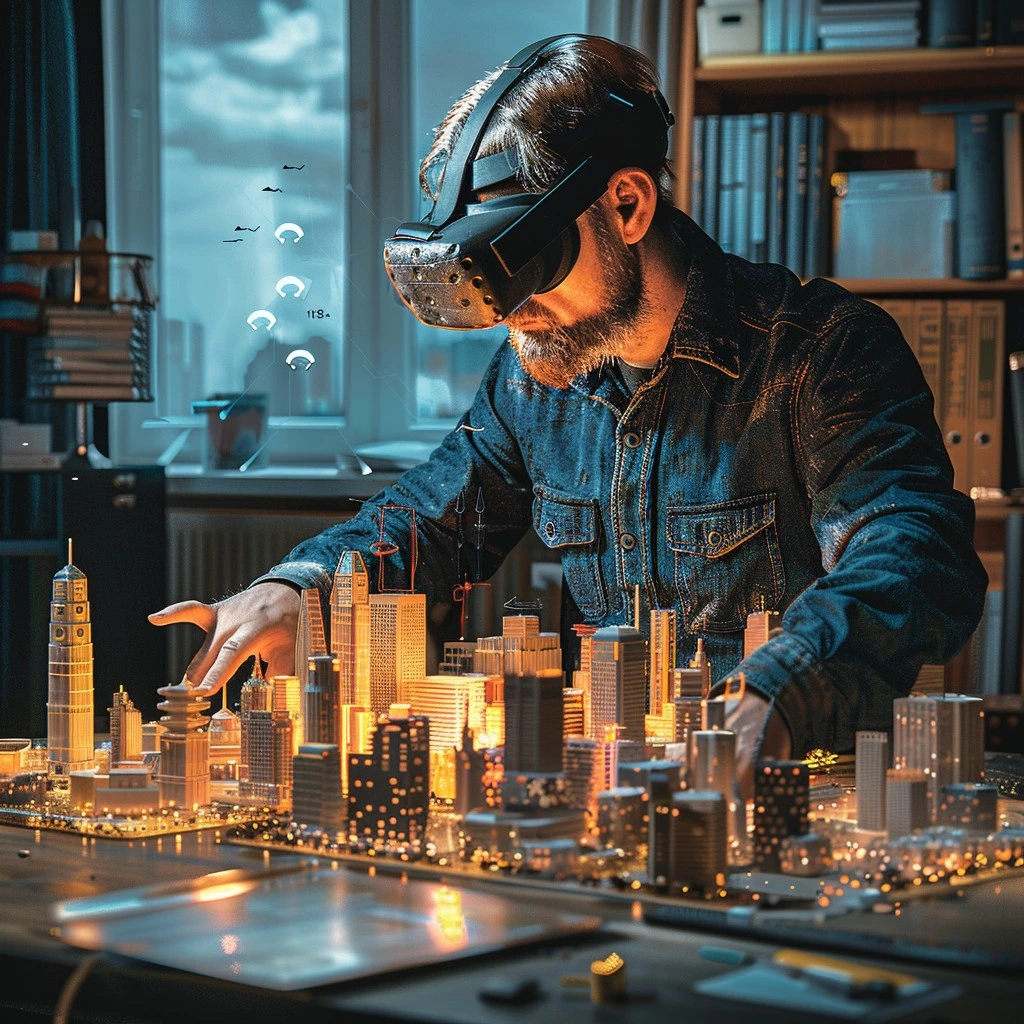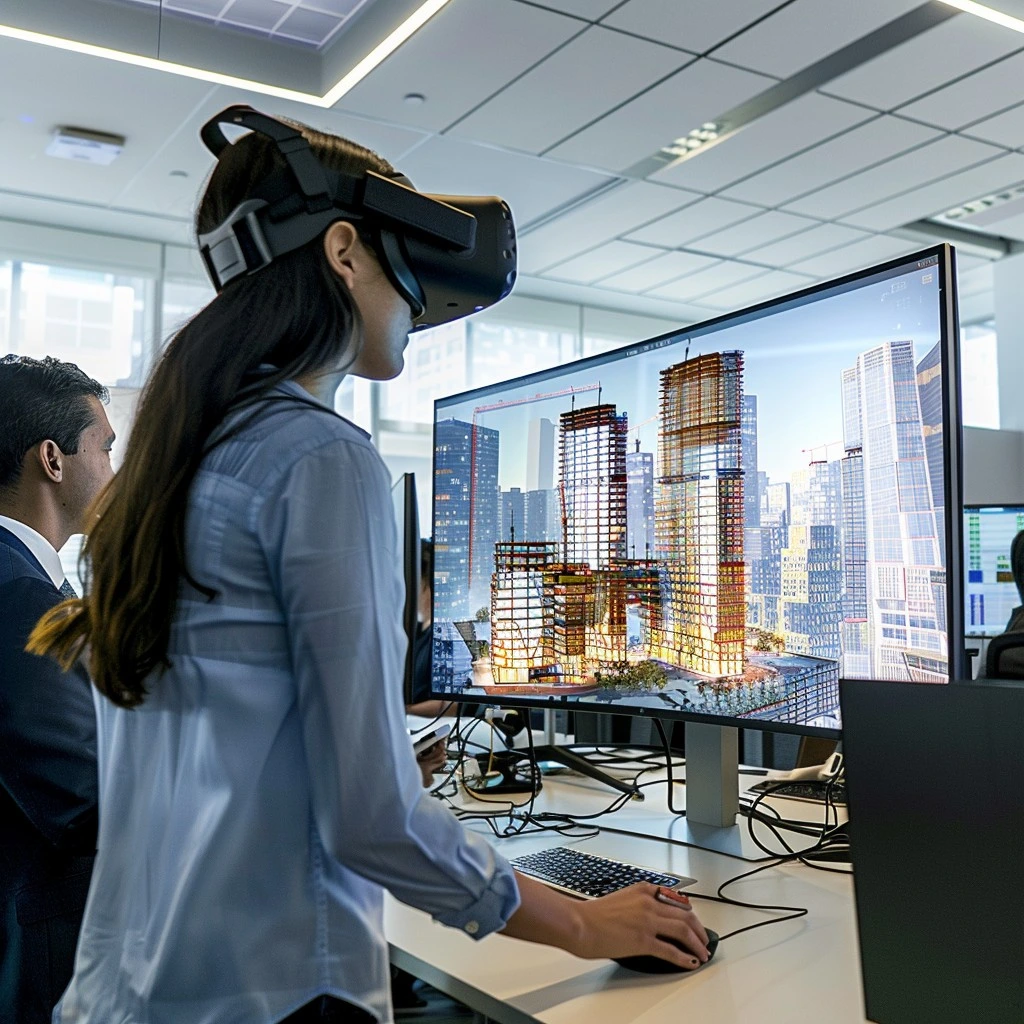
In recent years, Augmented Reality (AR) and Virtual Reality (VR) have rapidly evolved from niche technologies into mainstream tools with applications across various industries. Whether it’s enhancing gaming experiences, transforming educational methods, or redefining how businesses engage with customers, AR and VR are reshaping our digital world. In this article, we explore how these technologies are paving the way for a future of digital immersion and their potential to revolutionize our interaction with the virtual and physical environments.

1. Understanding Augmented and Virtual Reality
Augmented Reality (AR) and Virtual Reality (VR) are two groundbreaking technologies that have dramatically reshaped how we interact with digital content. While both AR and VR provide immersive experiences, they operate in fundamentally different ways and have unique applications across various industries. This article aims to explore what AR and VR are, how they work, and their potential impact on our everyday lives.
What is Augmented Reality (AR)?
Augmented Reality enhances the real-world environment by overlaying digital elements such as images, videos, or interactive data onto the physical world through devices like smartphones, tablets, or AR glasses. Unlike VR, AR doesn’t replace the real world but augments it by adding contextual information.
For example, AR applications can provide real-time navigation assistance, allowing users to see directions and landmarks overlaid on their view of the streets. In retail, AR enables customers to visualize how furniture might look in their homes before making a purchase. The technology’s ability to blend digital content with the physical world has unlocked new possibilities for education, entertainment, and business.
What is Virtual Reality (VR)?
Virtual Reality, on the other hand, is a fully immersive technology that transports users to a completely virtual environment. Using VR headsets, users can explore simulated worlds, interact with digital objects, and even engage in activities like gaming, training simulations, or virtual tourism.
Unlike AR, which works in conjunction with the real world, VR creates an entirely new reality, isolating users from their physical surroundings. This isolation allows for a deeper level of immersion, making VR particularly effective for training and educational purposes. For instance, VR can be used to simulate dangerous scenarios for firefighters or provide medical students with virtual surgeries.
Key Differences Between AR and VR
While both technologies offer immersive experiences, the primary difference lies in their interaction with the real world. AR enhances reality by adding digital elements, whereas VR creates a separate, fully virtual world. This fundamental difference results in varying use cases and applications:
- AR Applications: Used for navigation, retail visualization, interactive gaming, and educational tools.
- VR Applications: Utilized in gaming, virtual tourism, immersive training, and therapeutic practices.
Applications of AR and VR in Various Industries
- Healthcare:
- AR is being used for real-time visualization during surgeries, helping surgeons to overlay crucial data directly onto the patient’s body.
- VR offers virtual training environments for medical students and therapeutic settings for treating PTSD or phobias.
- Education:
- AR can bring textbooks to life with interactive 3D models and engaging visual content.
- VR provides students with immersive learning experiences, such as virtual field trips or historical reenactments.
- Retail and Marketing:
- AR enables virtual try-ons for clothing and accessories, allowing customers to see how products look without physically trying them on.
- VR creates immersive marketing experiences, such as virtual store tours or interactive product demonstrations.
- Entertainment and Gaming:
- AR games like Pokémon Go blend the real world with digital gameplay, encouraging exploration and interaction.
- VR has revolutionized the gaming industry with fully immersive environments, offering players unparalleled experiences.
Challenges and Limitations
Despite their potential, AR and VR face several challenges. For AR, the biggest hurdles include technical limitations like accurate object recognition and tracking in varying environments. There are also concerns about privacy and data security, as AR applications often require access to real-world data.
For VR, the main challenges are high costs and the need for powerful hardware. Moreover, prolonged use of VR can lead to motion sickness and discomfort for some users. These challenges need to be addressed to achieve widespread adoption and unlock the full potential of these technologies.

The Future of AR and VR
The future of Augmented and Virtual Reality looks promising as technology advances and new applications emerge. With the development of more sophisticated hardware and software, AR and VR will likely become more integrated into our daily lives. From smart glasses that provide real-time information to fully immersive VR environments for remote work and social interactions, the possibilities are endless.
As the technology matures, we can expect a convergence of AR and VR, leading to the rise of Mixed Reality (MR) environments that combine the best of both worlds. This hybrid approach could redefine our digital experiences, offering new ways to interact with information, entertainment, and each other.
Understanding Augmented and Virtual Reality is crucial as these technologies continue to evolve and influence various aspects of our lives. While they have their challenges, the potential benefits and applications of AR and VR are vast. As we move towards a future where digital and physical worlds blend seamlessly, staying informed about these technologies will be essential for navigating and leveraging their transformative power.
2. Applications of AR and VR Across Industries
The adoption of AR and VR is not limited to entertainment. These technologies are transforming various sectors, providing innovative solutions and creating new business opportunities.
a) Education and Training
AR and VR are revolutionizing education by making learning more interactive and immersive:
- Virtual Classrooms: VR allows students to attend classes in virtual environments, making education accessible regardless of geographic location. Virtual labs and classrooms provide an interactive learning experience where students can engage with 3D models and simulations.
- Skill Training: VR is being used for professional training in fields like healthcare, aviation, and engineering. Medical students can practice surgeries in a risk-free environment, while pilots can undergo flight simulations to improve their skills.
- AR in Learning: Augmented reality textbooks and apps make learning more engaging. For instance, students can scan pages to see 3D models pop up, enhancing their understanding of complex subjects like biology or history.
b) Healthcare
AR and VR are making significant inroads in healthcare by improving patient care and medical training:
- Surgical Training and Planning: VR simulations allow surgeons to practice complex procedures in a controlled environment. AR can also assist surgeons during operations by overlaying vital information onto the patient’s body.
- Therapy and Rehabilitation: VR is used in therapy to treat conditions such as PTSD and anxiety disorders by exposing patients to controlled environments. In rehabilitation, VR games motivate patients to complete exercises, improving recovery outcomes.
- Patient Education: AR helps patients understand medical conditions and treatment plans. For example, doctors can use AR to visualize anatomy and explain surgeries more effectively to patients.
c) Retail and E-commerce
The retail industry is leveraging AR and VR to enhance the shopping experience:
- Virtual Try-Ons: AR allows customers to try on clothes, makeup, or accessories virtually before making a purchase. This reduces return rates and improves customer satisfaction.
- Virtual Showrooms: VR enables customers to explore virtual showrooms, browse products, and make purchases from the comfort of their homes. This is particularly beneficial for high-end retail and automotive sales.
- Interactive Ads: AR advertisements offer interactive experiences, allowing consumers to engage with products in new ways, such as scanning a product to see its features or using an AR app to view a product in their home.
d) Real Estate and Architecture
AR and VR are changing how properties are showcased and designed:
- Virtual Tours: VR enables potential buyers to take virtual tours of properties, even from thousands of miles away. This is particularly useful for international real estate transactions and during times when in-person visits are not possible.
- AR in Architecture: Architects use AR to visualize buildings in the real world, allowing clients to see how a structure will look in its intended environment. This helps in making design decisions and understanding spatial relationships.
e) Entertainment and Gaming
Entertainment and gaming were among the first industries to adopt AR and VR, and they continue to push the boundaries of what these technologies can do:
- Immersive Gaming: VR games offer fully immersive experiences, allowing players to step into virtual worlds. AR games, like Pokémon GO, blend the virtual with the real world, creating a new genre of interactive gaming.
- Virtual Concerts and Events: Artists and event organizers use VR to host virtual concerts, providing an immersive experience to fans worldwide. This has become particularly relevant in the wake of global events limiting physical gatherings.
- Interactive Storytelling: AR and VR are transforming storytelling by making viewers active participants in the narrative. This new form of entertainment blurs the line between the audience and the story.
3. Challenges and Limitations
Despite their potential, AR and VR face several challenges that must be addressed to achieve widespread adoption:
- Cost and Accessibility: High-quality VR headsets and AR devices are still expensive and not accessible to everyone. This limits the widespread use of these technologies.
- Technical Limitations: Issues like motion sickness, limited field of view, and resolution challenges hinder the user experience in VR. AR devices often suffer from battery life and display limitations.
- Content Creation: Developing content for AR and VR is complex and time-consuming. The lack of standardization and the need for specialized skills can slow down content creation.
- Privacy and Security: As AR and VR collect and use personal data to enhance user experiences, privacy and security concerns arise. Protecting user data and preventing unauthorized access are critical.
4. The Future of AR and VR: What to Expect
Augmented Reality (AR) and Virtual Reality (VR) have made significant strides in recent years, transforming how we interact with digital content and the physical world. As technology continues to evolve, these immersive experiences are expected to become even more integrated into our daily lives. This article explores the future of AR and VR, highlighting the potential advancements, challenges, and what we can expect from these transformative technologies.
Advancements in AR and VR Technology
- Enhanced Hardware and Accessibility
- Future AR and VR devices are expected to become more compact, powerful, and affordable. Companies are working on lightweight AR glasses and standalone VR headsets that provide better resolution, longer battery life, and improved comfort. These advancements will make the technology more accessible to a broader audience and enhance user experiences.
- 5G and Edge Computing Integration
- The integration of 5G and edge computing will revolutionize AR and VR experiences by significantly reducing latency and improving data processing capabilities. This will enable more seamless and interactive experiences, such as real-time multi-user interactions in virtual spaces and augmented reality applications that require precise and immediate responses.
- Mixed Reality (MR) Environments
- The convergence of AR and VR technologies is paving the way for Mixed Reality (MR) environments. MR combines elements of both AR and VR, allowing digital and physical objects to coexist and interact in real-time. This hybrid approach will open up new possibilities for gaming, training, and collaborative work environments, creating more immersive and interactive experiences.
- AI-Powered Experiences
- Artificial Intelligence (AI) will play a crucial role in the evolution of AR and VR. AI can enhance object recognition, spatial mapping, and natural language processing, leading to more intuitive and context-aware applications. This will enable AR and VR systems to provide personalized experiences, such as virtual assistants that can understand and respond to user needs in real-time.
- Improved Content Creation Tools
- The future of AR and VR will also see advancements in content creation tools, making it easier for developers and designers to create immersive experiences. New software platforms will enable the development of interactive environments, 3D models, and realistic simulations with less effort and expertise. This democratization of content creation will lead to a surge in innovative applications across various industries.
Key Applications of AR and VR in the Future
- Healthcare and Therapy
- AR and VR are set to revolutionize healthcare by providing innovative ways to train medical professionals, plan surgeries, and treat patients. Virtual reality can create realistic simulations for medical training, while augmented reality can assist surgeons with real-time information during operations. In therapy, VR is already being used to treat phobias, PTSD, and anxiety, and these applications are expected to expand.
- Education and Training
- The future of education will be deeply impacted by AR and VR. Virtual classrooms, immersive field trips, and interactive simulations will provide students with engaging learning experiences that go beyond traditional methods. In professional training, these technologies will offer realistic scenarios for skill development, from operating complex machinery to practicing emergency response procedures.
- Remote Work and Collaboration
- As remote work becomes more prevalent, AR and VR will play a crucial role in facilitating collaboration and communication. Virtual meetings, shared workspaces, and collaborative design environments will enable teams to work together as if they were in the same physical space, regardless of location. This will enhance productivity and foster more effective teamwork in a remote-first world.
- Retail and Marketing
- The retail industry will see significant transformations as AR and VR become more integrated into the shopping experience. Virtual stores, augmented product displays, and interactive fitting rooms will allow customers to explore and try products without leaving their homes. This personalized and immersive approach will redefine customer engagement and loyalty.
- Entertainment and Gaming
- The entertainment and gaming industries are already embracing AR and VR, and this trend will continue to grow. More immersive gaming experiences, interactive storytelling, and virtual concerts are just a few examples of how these technologies will change how we consume entertainment. As content libraries expand and hardware improves, AR and VR will become staples of modern entertainment.

Challenges and Considerations
- Technical Limitations
- Despite the progress, AR and VR still face technical challenges, such as limited field of view, motion sickness, and hardware constraints. Addressing these issues will be crucial for widespread adoption.
- Privacy and Security
- As AR and VR collect and process vast amounts of personal data, privacy and security concerns will become more prominent. Ensuring data protection and ethical use of these technologies will be essential for gaining user trust.
- Content Availability
- The success of AR and VR depends heavily on the availability of high-quality content. While content creation tools are improving, developing engaging and diverse experiences remains a challenge that must be addressed to attract and retain users.
- Social and Ethical Implications
- The immersive nature of AR and VR raises questions about their impact on social interactions and mental health. Prolonged use could lead to social isolation or addiction, and there are concerns about the potential misuse of these technologies. Establishing guidelines and promoting responsible use will be critical as AR and VR become more prevalent.
The future of AR and VR holds immense potential for transforming how we interact with the world, offering new opportunities in fields ranging from healthcare and education to entertainment and retail. While there are still challenges to overcome, ongoing advancements in hardware, software, and connectivity will continue to push the boundaries of what’s possible. As these technologies evolve, they will not only change the way we experience digital content but also redefine our relationship with the physical world. For businesses and individuals alike, understanding and preparing for the future of AR and VR will be key to leveraging their full potential.

Conclusion
Augmented and Virtual Reality Technologies are no longer futuristic concepts; they are shaping the present and future of digital interactions. By providing immersive experiences that blend the real and virtual worlds, AR and VR are set to revolutionize industries, redefine how we engage with digital content, and open up new avenues for innovation and creativity. As technology advances and adoption grows, the line between reality and the virtual will continue to blur, leading us into an era of unparalleled digital immersion.
by: clevermkt and clever marketing





